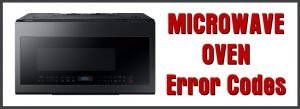
When this error makes its unexpected appearance, it can be confusing and even a little frustrating, especially if you’re not familiar with microwave lingo. But here’s the deal: understanding what might be causing this can make a world of difference. Instead of feeling left in the dark, we’re gonna shine some light on the possible reasons behind this code, helping you figure out your next steps. It’s easier than you think, and by the end of this article, you’ll have a good grasp of what to do.
Understanding the E3 Error Code
First things first, let’s dive a bit deeper into what an E3 error code actually means. In technical terms, this error relates to a problem with the temperature sensor, often called the thermistor. You can think of this sensor like a thermostat in your home – it keeps track of temperature and helps the microwave adjust its power levels for efficient cooking. If this sensor isn’t working correctly, it’s like trying to bake cookies in an oven without a temperature gauge. You might end up with half-baked dough or burnt crisps!
The E3 code signals that something is preventing the sensor from doing its job properly. Sometimes, it might be as simple as the sensor being dirty or covered with food particles. Imagine putting a mitten over a thermometer – it won’t get an accurate reading, right? Similarly, dirt or residuals can block effective temperature readings. In other cases, the sensor might be malfunctioning due to a defect or because it’s reached the end of its lifecycle. Essentially, your microwave is trying to communicate that it can’t maintain the optimal cooking balance.
So, what happens next? Well, the E3 code is your microwave’s way of saying, “Hey, I need a little check-up over here!” Addressing this issue promptly can ensure your microwave keeps running smoothly, saving you time and money in the long run. Let’s explore some of these causes in more detail.
Possible Causes and Solutions
Alright, now that we have an understanding of the error code and its purpose, let’s look at what might cause this sensor to act up. One of the most common culprits is an electrical glitch or power surge. Just like when you might get a static shock after walking on carpet, these surges can disrupt the sensitivity of the sensor. Luckily, this issue might just need a simple reset. Unplugging your microwave for about 10 minutes can sometimes do the trick, allowing its electronic components to settle back to their usual state.
Another possibility is a faulty or broken temperature sensor. Over time, and with frequent use, these sensors can wear out or fail altogether. It’s no different than a light bulb that eventually burns out after hours of use. If the sensor is faulty, you might need a technician to replace it. While it might sound daunting, getting this fixed can significantly extend your microwave’s lifespan, saving you from buying a new appliance.
Yet another factor could be an issue with the microwave door not sealing properly. If the door doesn’t close as it should, it can lead to heat loss, confusing the temperature sensor. You might notice the latch isn’t catching correctly or the door seems misaligned. In many cases, simply ensuring the door is properly closed during use can prevent further errors.
Prevention Tips and Next Steps
Wondering how you can prevent this pesky E3 error from reappearing? Let’s talk prevention. Like anything in your home, your microwave benefits from a little TLC. Regular cleaning can help keep the temperature sensor free of grime and ensure it operates optimally. This doesn’t need to be a deep clean every time – just a quick wipe down with a damp cloth can do wonders.
In addition, try to avoid slamming the microwave door. Gentle closing can prevent misalignment and ensure a good seal, reducing the chance of temperature fluctuations that might set off the error code. Think of it like your refrigerator door – keeping it properly closed helps everything inside stay at the right temperature!
If the error persists after trying these steps, it might be time to consult with a professional appliance repair service. While it’s tempting to tackle these issues on your own, specialized knowledge can sometimes be necessary to prevent further complications. Remember, addressing the problem sooner rather than later can help keep your trusty microwaving companion in top shape.
Ultimately, understanding and solving a Samsung microwave’s E3 error code is within your reach. By following these insights and suggestions, you’ll be back to warming up those leftovers in no time. So breathe easy, because now you’ve got the tools and knowledge to tackle this little hiccup head-on.